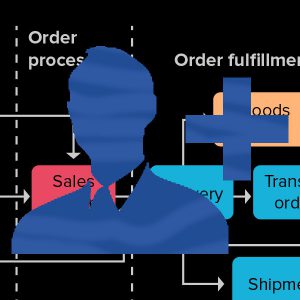HOW RPA IS TRANSFORMING CRM U0026AMP; ERP
January 31, 2019
Having deployed more than 4,000 software robots into production environments, our global Robotic Process Automation (RPA) team at Capgemini has visibility into some interesting trends.
 One of the most compelling involves the convergence of CRM (Customer Relationship Management) platforms like Salesforce with ERP (Enterprise Resource Planning) packages such as SAP.
One of the most compelling involves the convergence of CRM (Customer Relationship Management) platforms like Salesforce with ERP (Enterprise Resource Planning) packages such as SAP.
A little bit of background for those new to RPA: software ‘bots’ are not physical robots like those used in manufacturing; they are instead software applications that can replace human-driven activities that are repetitive and rule-based.
RPA is one of the hottest areas of enterprise technology because of its ability to transform conventional business processes on several axes: financially (through labor arbitrage with virtual vs. human FTEs); capacity (bots can run 24×7 if needed); cycle-time reduction; error-rate reduction; and qualitative improvements in value-added work for humans.
Most importantly, RPA efforts typically feature rapid ROI that allow businesses to quickly gauge suitability for addressing major process bottlenecks or scalability challenges.
With that as background, here are some of the more interesting trends we’re seeing in shops with disparate marketing, sales, distribution and accounting systems.
Customer Account Creation and Maintenance
Most large companies have subscription services that allow them to check the creditworthiness of prospective or existing customers.
We know of a large organization that once dedicated a significant amount of manual effort to:
- Reviewing D&B reports and other credit bureau services when new accounts are created in Salesforce
- Using Excel-based business rules to accept, reject or especially disposition the customer account
- Routing the acceptance, rejection or escalation to the appropriate parties including the sales and accounting organizations, during which many different systems are updated
- Periodically re-validating existing accounts to ensure customers remain creditworthy
We see RPA transforming these processes significantly. Imagine a scenario in which bots are used to:
- Automatically pull credit reports both upon the creation of a new account or on a recurring basis for existing customers;
- Execute business rules that approve, reject or escalate customer account issues;
- Automatically propagate suspensions or rejections to both CRM and downstream systems such as AR (Accounts Receivable) for special handling by the sales and accounting teams
Put simply, bots can pay for themselves very quickly by ensuring that new or existing customers are creditworthy — and doing so on a cadence that humans would be challenged to replicate.
Quote-to-Cash
One of the challenges large organizations frequently encounter is the data silos that exist between CRM and ERP systems.
Consider a sales representative who is asked to generate a quote for a customer. The sales rep will interact with the organization’s CRM system to record the request, generate a formal quotation document in another system, and then route a task to the sales support team to update marketing and accounting systems with the details of the order.
Some organizations orchestrate these activities in a fairly manual way, replete with swivel-seat and repetitive data entry tasks.
Now imagine the same process with RPA helping to streamline the sales team’s activities, making each team member more productive:
- Quotations and metadata regarding the proposal are automatically entered into the CRM system for forecasting and reference purposes
- Detailed information about the quote is rapidly and accurately propagated into related marketing and sales systems (e.g., a campaign management system to provide granular feedback on current marketing efforts)
- Upon receipt of the order, bots help propagate data into order-processing systems and other downstream platforms that require accurate and synchronized data
When companies talk about being “easier to do business with”, bots can frequently play an important role in helping reduce friction between buyers and sellers.
Order-to-Cash
In its simplest form, the typical Order-to-Cash (O2C) process involves four major steps:
- Order processing, where the order is digested and interpreted
- Order fulfillment, during which the order is assembled and goods readied for shipment
- Billing, in which invoices are generated and account receivable systems are updated
- Payment processing and collections
Of course, each company handles the O2C process differently, but one of the recurring themes we have observed is the amount of manual data entry that can occur at several critical steps.
For example, many large organizations often utilize separate MRP (material resource planning), inventory management and accounting systems (and have multiples of each).
In situations where an IT department has not had sufficient time or capacity to fully integrate these systems — especially where mergers and acquisitions have occurred on a regular basis — we see bots playing critical roles in the synchronization of data.
This allows a level of data consistency that ensures each system accurately reflects critical sales data throughout the order lifecycle.
Imagine an O2C process where MRP, ERP, inventory management, and related or redundant systems all maintain a consistent version of the “truth”; virtually all related financial processes become faster and the level of trust that stakeholders have in the data increases.
The Bottom Line
With recent advances in RPA technology — and its increasing ability to demonstrate cognitive capabilities (e.g., OCR, chatbots, etc.) — we see organizations using RPA to rapidly integrate key marketing, sales, order processing, distribution and accounting activities.
Further, this trend does not appear to be slowing; rather, we see it accelerating at a fairly rapid pace.
Companies focused on customer experience would do well to consider whether RPA has a role to play in streamlining their critical, customer-facing processes.
Doug Ross is a Vice President and National Solutions Architect for Disruptive Technologies at Sogeti USA, part of Capgemini. You can contact Doug atdoug.ross@us.sogeti.com.

 English | EN
English | EN 